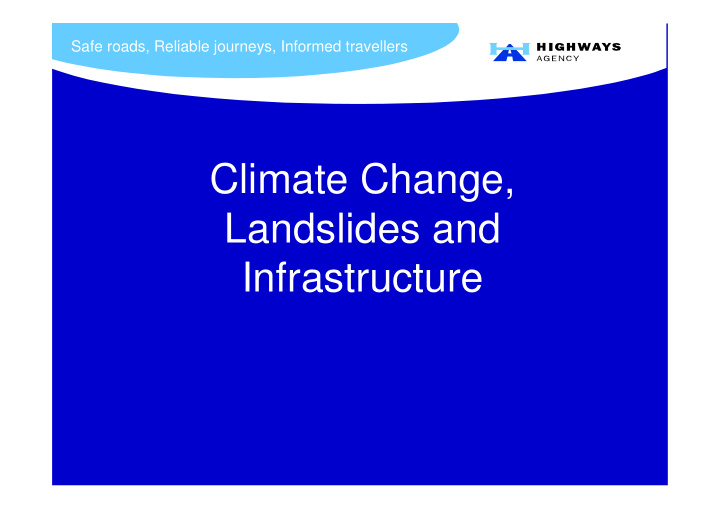



Safe roads, Reliable journeys, Informed travellers Climate Change, Landslides and Infrastructure
Context[1] • Times 13 October 2005 – Roads and a stretch of the West Coast Main Line closed after heavy downpours – landslides blocked roads in Dumfries and Galloway.
Context[2] • HA – 6000km of earthworks in England. • NR – 10000km of earthworks in England, Scotland and Wales. • BW – 3000km of assets in England, Scotland and Wales • LA’s - ?? • Need to emphasise that new works are a very small percentage of the asset < 0.5% per annum and age and condition of the assets varies considerably often related to construction methods used.
Context[3] HA – currently 40 – 50 failures per annum with annual maintenance spend in region of £12-15 million. NR – approximately 400 incidents per annum with annual spend on remedial works of £100 million. BW – still undertaking inspections of 2400 assets but spend since 1998 of the order of £36million. LA’s – no data.. The majority of current slope failures are associated with overconsolidated clays.
Context [4] • Climate Change and the Highways Agency TRL 2001 • The Changing Climate:Impact on the Department of Transport 2003? • The Department asked HA to review DMRB to carry out assessment of standards to identify revisions required in light of UKCIP’s scenarios. • Key impact is deterioration of highway infrastructure. • Embankments are at risk of both subsidence and heave. • Problems on rail network are expected to increase.
Ais Gill landslide (31/1/95) – Ultimate Limit state failure 31/1/95 Fatal Accident near Ais Gill (16.26 2H88 Carlisle to Leeds and 17.45 2H92 Carlisle to Leeds)
.
Flint Hall Farm
A34 Tothill
A10 Milton
Recent Experience • Scottish Road Network Climate Change Study • Scottish Road Network Landslide Study • Both documents published in June 2005 and available on website. • Best current practice documents but are they applicable elsewhere in UK?
Conclusions • Rainfall is most important parameter linked to future instability. • Annual rainfall in Scotland and elsewhere? is expected to show little change until 2020’s. • Rain has potential to cause significant landslide events and changes in groundwater levels reducing stability of cuttings. • More concern related to surface-water drainage, culvert design, flooding and increased run-off.
Recommendations • It is possible that in winter conditions groundwater levels may be higher than allowed for in the design of cuttings- no formal recommendations can be made without an appropriate climate change model being developed for this issue. • It is not possible with the information presently available to provide qualitative guidance on either groundwater levels or changes to rates of recharge to the groundwater body.
Precedent • In 2001 significant winter rainfall events lead to a considerable increase in the number of slope failures on the highway network in the South of England with more than 60 separate incidents on HA roads and many more on other roads. • Climate change or natural variation?
Summing Up [1] • Little or no current action to address issue of climate change related to slope stability? • No need to consider changes until at least 2020? • Relatively straightforward to design new earthworks but what assumptions do we make and how do we justify cost? • Major issue for all infrastructure owners relates to existing assets with at least 20000km in UK – what do we need to do to protect assets?
Summing Up [2] • Given that increased rainfall is main source of future instability have we sufficient confidence in current models if indeed they exist? • What type of increased rainfall has most impact i.e. short duration storms or general seasonal increase? • Storms are not new so what is going to change and is it significant? • What can we learn from other areas of the world where such storms are common? • Is better drainage the best and indeed the only solution?
Thank you
Recommend
More recommend